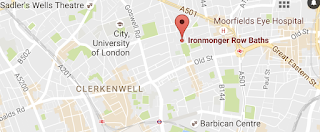Let's Go Geologizing (and fly a kite)!
Understanding what one is looking at on the ground adds greatly to the experience of touring the New Forest near Southampton. Because New Forest landforms are subtle, a keen eye is necessary to discern and decipher the clues of gravel shape, stream form, hill slope, and vegetation type. Winter is a great time to view the land as well as the landscape.
Geological Development of the New Forest
The area of the New Forest is underlain by chalk, laid down in Upper Cretaceous seas between 99 and 65 million years ago. This chalk bed dips to form a basin, which filled during the Eocene (ca. 56-34 million years ago) with sediments from transgressing seas, freshwater lakes and rivers. These strata were eventually uplifted and tilted towards the south, so that today there is a progression [like a tilted loaf of sliced bread with the top crust representing the overlying gravel and the stacked slice surfaces exposed] from north to south in the New Forest:
- the Lower Bagshot beds of deltaic origin
- the Bracklesham Beds of alluvial sand over clay
- the Barton Clay of marine origin
- the Barton Sand bed of loamy sand
- the Headon Beds of loamy clay and marine shell marls
In the Pleistocene (ca. 2 million to 10,000 years ago), these slanted beds were overlain by alluvial gravels, which now only survive on the high points of all the above geological beds.
New Forest Landscapes: Cliffs, Hilly Terraces, U-shaped Valleys
Piper’s Wait is billed as the highest point in the Forest. Surprisingly, it is not a mountain but one of nearly 150 named forest carparks, located on a high gravel terrace at the northern end of the Forest. Bordered on the north by the Bracklesham escarpment, the terrace represents the original, undissected surface of the Early Pleistocene floodplain gravels. The braided streams that laid down these gravels were early versions of the Avon and Solent Rivers.
Today the Avon flows down the western side of the Forest, having cut a spectacular river cliff affording views westward to chalk hills from the Castle Hill carpark. On the south, the Solent is now a submerged river valley forming the 1.2 –8 km wide sea passage between the New Forest and the Isle of Wight. In the Early Pleistocene it was an eastward flowing river that was capable of cutting terraces from west to east, flowing across a more extensive amount of land exposed by lowered sea levels and eventually into the river that drained the dry basin of the North Sea.
 |
| Erosional valley |
From Piper’s Wait, about twelve such terraces drop down to the sea, cut and filled successively during the Pleistocene. Unlike the highest terrace gravels, the middle terraces bear angular flints, indicating they were deposited by steep gradient streams which flowed across chalk — a substance now exposed to the surface only to the north and west beyond the New Forest. These middle terraces were heavily dissected in the Mid- to Late Pleistocene by small streams, but their U-shaped valleys have since been filled up with erosional deposits housing small bogs.
From Grass ‘Lawns’ to Heathland to Woods
The gravels forming the surfaces of the higher points in the Forest can support little but broad Calluna heathland. Exposed Bagshot and Bracklesham layers are also acidic and nutritionally poor, again hosting little but heather, gorse and self-sown Scots Pine. But the marine Barton Clay and Headon Beds and the loamy Barton Sands
 |
| Ornamental woodland |
While bogs are often thought to occupy the lowest point in the landscape, a tussock bog has formed on the hillslopes above Picket Brook. The water feeding this hillside bog comes from seeps along a hilltop juncture of overlying porous sands on impermeable clays. The tussock bog vegetation on the hillside is entirely different from the bracken on the sands of the hilltop above.
Geomorphology in Action
 |
| Point Bar in Linford Brook |
 |
| Nick point on Picket Brook |
Most visitors to the New Forest enjoy the trees and wide-open views from the heathland, but few look under their feet to the history of the land itself. It is a story beginning with the chalky sediments accumulating from Cretaceous Seas. The chalk was then covered by a succession of seabed and coastal sediments, which were uplifted as dry land. In the Pleistocene when the sea coast was south of the Isle of Wight, the Solent flowed across the Hampshire Basin towards the east, cutting the terraces of the New Forest area, stepping down from north to south.
References:
Chaffey, John (2009) “Geomorphology of the New Forest, Hampshire”. Fieldwalk handout.
Anon. (1986) The New Forest Landscape. CCP 220. Cheltenham, Glostershire: Countryside Commission.
















